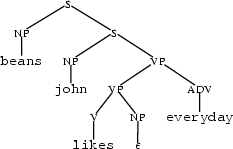4 Dominance Constraints
Trees are widely used for representing hierarchically organized information, such as syntax trees, first-order terms, or formulae representing meanings. A tree can be regarded as a particular type of directed graph. A directed graph is a pair  where
where  is a set of vertices and
is a set of vertices and  a multiset of directed edges between them, i.e. a subset of
a multiset of directed edges between them, i.e. a subset of  . A forest is an acyclic graph where all vertices have in-degree at most 1. A tree is a forest where there is precisely one vertex, called the root, with in-degree 0; all others have in-degree 1.
. A forest is an acyclic graph where all vertices have in-degree at most 1. A tree is a forest where there is precisely one vertex, called the root, with in-degree 0; all others have in-degree 1.
First-order terms, or finite constructor trees, are characterized by a further restriction: each node is labeled by some constructor  of a signature
of a signature  , and its out-edges are labeled by integers from 1 to n, where n is the arity of the constructor. This can be formalized as follows: we assume a signature
, and its out-edges are labeled by integers from 1 to n, where n is the arity of the constructor. This can be formalized as follows: we assume a signature  of function symbols
of function symbols  , each equipped with an arity
, each equipped with an arity  . A finite constructor tree is then a triple
. A finite constructor tree is then a triple  where
where  defines a finite tree, and
defines a finite tree, and  and
and  are labelings, and such that for any vertex
are labelings, and such that for any vertex  there is exactly one outgoing edge with label
there is exactly one outgoing edge with label  for each
for each  and no other outgoing edges.
and no other outgoing edges.
Trees are often used to represent syntactic structure. For example, here is a possible analysis of "beans, John likes everyday".

or logical formulae representing meanings. For example, here are the simplified representations of the two meanings of the ambiguous sentence "every yogi has a guru":
